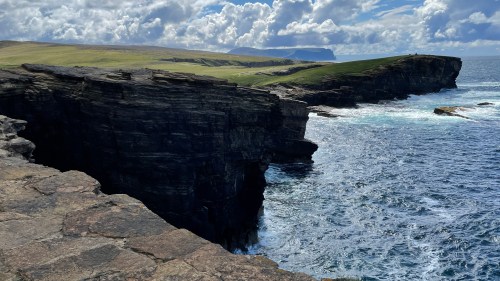We can’t believe the spacious car park at Rackwick allows 7 nights free for campers and caravans, and what’s more, that we never saw more than two others during our time there. There’s also a clean toilet block in an old stone building, not to mention the stunning view. What a perfect campsite!


The car park marks the starting point for the hike to the Old Man of Hoy with nearby Rackwick Beach a destination in itself. It’s a rugged expanse of boulders churned nearly round by the sea and tossed onto a swath of pinkish sand. Mainland Scotland is only about eighteen miles away, but I wouldn’t want to be out there on this choppy sea.


Do I need to mention the wind? We’re still debating whether we’re up to the hike to the Old Man, and this ferocious wind is one of the factors under consideration.
Just above the beach is a traditional bothy offered as free shelter to campers, no reservations required. You can stay inside or pitch a tent in the walled yard. There was no one there the day we visited but during our stay we saw a few cyclists and backpackers take refuge from the weather.




Every day four or five cars arrive at the car park from the morning ferry and we watch the occupants prep for the trek: hiking shoes, rain gear, woolen caps, daypacks, cameras, binoculars, water, trekking poles. We amuse ourselves by guessing the ages of the hikers and make note of the time they return and how knackered they are. On a particularly windy and rainy day a group of four very fit-looking men staggered back and collapsed on the gravel, then fired up a camp stove right in the car park for a warming cuppa. Right then we knew it was prudent to wait for better weather. A wet cliff hike in low visibility isn’t high on my to-do list.
While we monitor the weather we visited the Dwarfie Stane, a Neolithic chambered tomb carved from a massive block of sandstone. It’s thought to be the only one of its kind in Britain, hewn from stone rather than built from stone. The stone is a glacial erratic and measures about 28 feet by 14 feet.

It’s hard to imagine the time and effort required to chisel the entrance and chambers using only other stones.



There’s some 18th and 19th century graffiti. One is an inscription in Persian: “I have sat two nights and so learnt patience.”


Our patience with the weather was rewarded and we picked a good day for the assault on the Old Man. I had to move our ferry reservation back a few days. and when I called the office to change it the clerk assumed we wanted to leave sooner. She sighed and asked, “What time tomorrow do you want to leave?”
“No,” I said. “We want to stay longer.”
“Oh!” she brightened. I guess tourists don’t stay long in a place that has a tough time filling a top ten list of What To Do In Hoy. We love it though, and I think the fact that we’re in our own home wherever we go makes the difference between looking for something to do and just being able to appreciate the beautiful place we’re in.































































































































